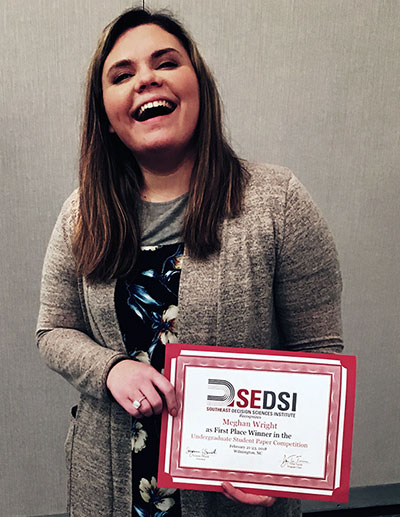Research
Student Research Awards
Congratulations to Suhaima Jamal for Winning Best Presenter Award at IEEE Annual UEMCON’23
We are absolutely delighted to share that Ms. Suhaima Jamal has received the Best Presenter Award at the annual IEEE Ubiquitous Computing, Electronics & Mobile Communication Conference (UEMCON 23), held from October 12th to 14th at Columbia University in New York. The annual IEEE UEMcon conference serves as a vital platform, facilitating the exchange of ideas, knowledge, and innovations among researchers, educators, and students, not only within the USA but also from different corners of the world.
“Having my research papers accepted at this conference and presenting them to respected scholars has been a truly enlightening experience. What makes it even more special is the incredible recognition I received amidst a gathering of distinguished scholars and researchers from numerous universities across the USA and a multitude of countries. I want to extend my deep appreciation and thanks to my supervisors, Dr. Chen, Dr. Cruz, and Dr. Kim, for their continuous support throughout my work on the papers.” she said.

Other Student Research Awards
IT Student Wins Best Undergraduate Paper Award at SE DSI
Caitlin McOsker won the award for the best undergraduate research paper at the Southeast Decision Sciences Institute (SE DSI) conference on February 12-14, 2020 in Charleston, SC.
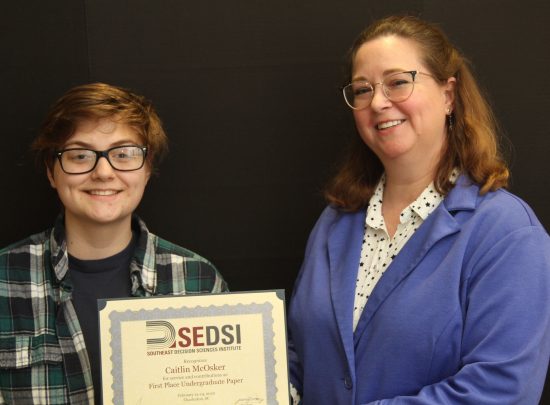
Her paper documented a process for scraping, cleaning, processing and analyzing job ads using Python. The text was analyzed to look at characteristics of IT jobs. Dr. Cheryl Aasheim served as her faculty mentor on the project.
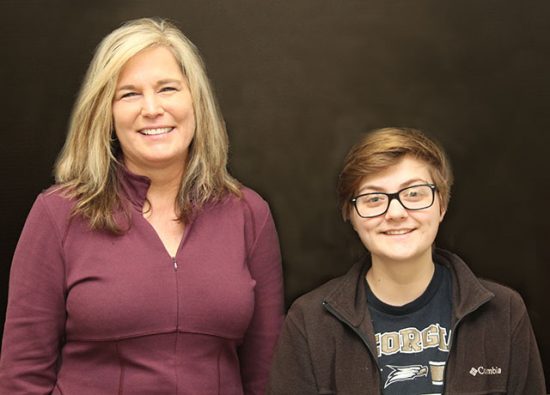
MSAE Student Sushmita Khan and Drs. Kaleta and Yin Win Best Paper Award at SAIS 2018
Drs. Jeffrey P. Kaleta and Jingjing Yin along with Ms. Sushmita Khan won the Best Faculty / Student Paper Award at the 21st Annual Meeting of the Southern Association of Information Systems (SAIS) in Atlanta, GA. Their paper, Twitter Sentiment Toward Autism During Autism Awareness Month, was presented by Dr. Kaleta and Ms. Khan at the 2018 annual SAIS conference held on March 23-24th.
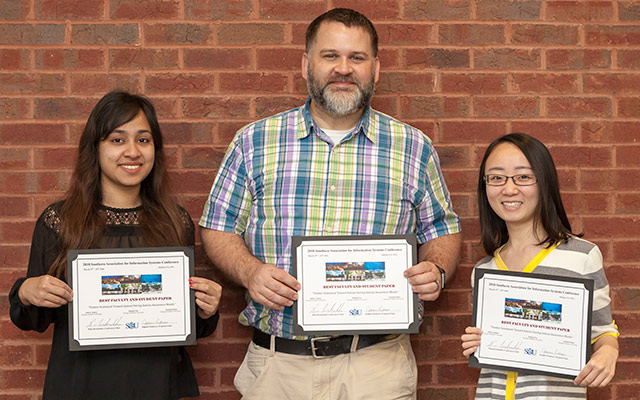
This study was a collaborative project investigating the topics and public opinions during autism awareness month as expressed on Twitter, a social media platform. The outcome of this work is the first of several initiatives investigating public views of health-related concerns over social media, making use of a variety of text analysis techniques.
Dr. Kaleta is an assistant professor in the Department of Information Technology within the Allen E. Paulson College of Engineering and Computing, Dr. Yin is an assistant professor in the department of Biostatistics located within the Jiann-Ping Hsu College of Public Health, and Ms. Khan is completing her Master’s of Applied Engineering in IT this Spring 2018.
IT Students Win SE Decision Sciences Institute 2018 Best Paper Award
Ryan Wilcauskas, Meghan Wright and Kaitlin Reid won the Best Undergraduate Student Paper Award at the 48th Annual Meeting of the Southeast Decision Sciences Institute in Wilmington, NC. The title of their paper was The Impact of Workplace Practices on Patients Seeking Mental Health Treatment: A Decision Tree Approach.
Part of the paper came from the work they did in a data mining course taught by Dr. Cheryl Aasheimthat they took as part of their degree program, Bachelor of Science in Information Technology, in Fall 2017. They continued their work under the mentorship of Dr. Aasheim, running additional models and refining the paper after class ended through the winter break.
Ryan and Meghan attended the conference on February 21-23, 2018. Kaitlin graduated this past Fall and, therefore, could not attend. The students received certificates and a monetary award.
The students received funding to attend the conference through an undergraduate research grant they won in the Allen E. Paulson College of Engineering and Computing competition.
IT Graduate and Undergraduate Students Win Best Paper Award at SE DSI 2017
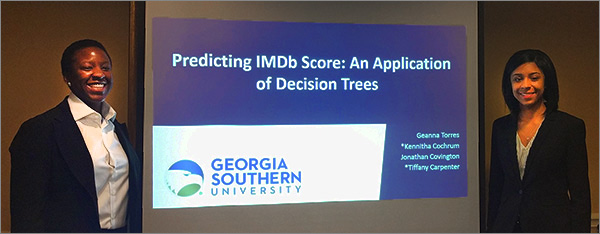
The paper titled “Predicting IMDB Score: An Application of Decision Trees” by Geanna Torres, Kennitha Cochrum, Jonathan Covington and Tiffany Carpenter took first place in the undergraduate student paper award competition at the 2017 meeting of Southeast Decision Sciences Institute (SE DSI). The 47th annual conference was held in Charleston, SC on February 22 – 24, 2017. Kennitha Cochrum and Tiffany Carpenter were the presenters at the conference. Geanna, Kennitha, Jonathan and Tiffany are all seniors in the BS in Information Technology program at Georgia Southern University.
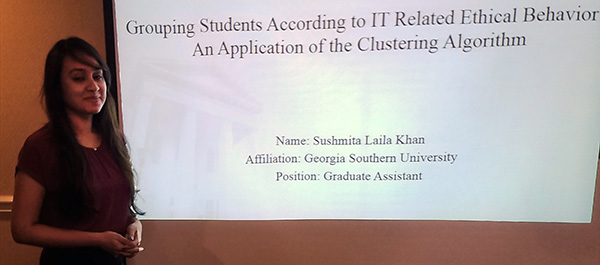
The paper titled “Grouping Students According to IT-Related Ethical Behavior: An Application of the Clustering Algorithm” by Sushmita Khan took first place in the graduate student paper award competition. Sushmita is in her second semester in the MS in Applied Engineering in the IT track.
SE DSI is a regional subdivision of the Decision Sciences Institute, a professional organization of academicians and practitioners interested in the application of quantitative and behavioral methods to the problems of society.
All students started the project in their data mining course in the IT program last semester and were mentored by their faculty advisor, Dr. Cheryl Aasheim, Professor of Information Technology.
IT Students Win Undergraduate Student Best Paper Award for Southeast Decision Sciences Conference
Congratulations to Information Technology students Jordan Bacon, Chris Bergin, Michael Canter and Matthew DeAngelis for winning the Best Paper Award in the Undergraduate Student Research track at the Southeast Decision Sciences Institute conference held in Savannah on February 25 – 27th, 2015.
Under the direction of Dr. Cheryl Aasheim, these students authored a paper titled Analysis of Georgia Southern University Student College Football Attendance that utilized data mining techniques to analyze factors that affect football attendance at Georgia Southern University. The students presented their paper at the conference on February 26, 2015.
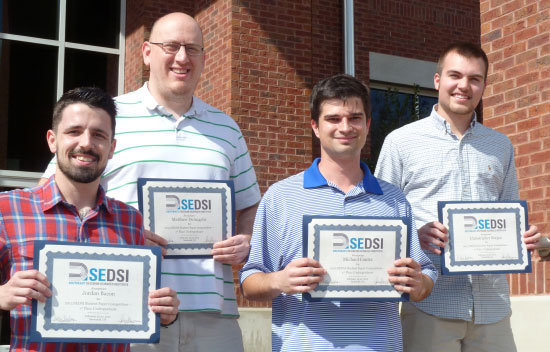
The research was an extension of a semester long project the students completed in their data mining course that is part of the Information Management specialization within the BS in Information Technology Program.
Networking Research Labs
There are two labs that mirror images of each other, separated by a folding wall. Each lab has 36 seats or 72 when joined. It is rare that we join the rooms for instruction. Joining the rooms is utilized for special events when the standard classroom model is not needed.
The student seating is arranged for easy access for the faculty member to move behind the students to offer support. The desks are lab tables that stand taller than an average computer table and require taller chairs. The tables are significant enough to allow students to build, dismantle, and diagnose other equipment, adding to the adaptability of the lab. The height of the tables allow students to work at the tables without having to be seated. Seats are simple rolling stools with backs.
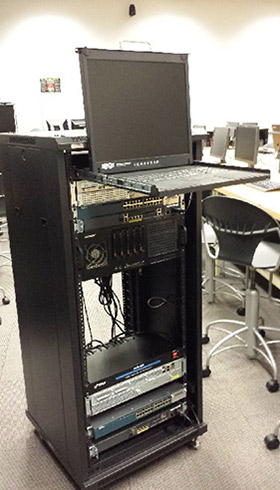
The room is carpeted with simple 2×2 carpet squares. This allows portions of the carpet to be replaced when stained or worn but more importantly, allows students to be able to remove sections of the carpet to expose the raised flooring below. The raised flooring is only 4 inches high but allows for the room to change over time and allows the network floor boxes to be easily maintained. It also allows students to work with structured cabling and not just patch cables.
There are two networks in each classroom: one private to the classroom and one that connects to the campus network. Each of the classrooms is on an individual vlan so that if and when students make mistakes, problems are confined to the classroom. The private network allows students to build and test many different scenarios without worry of damage to exterior systems. Both networks terminate in floor boxes and are then connected into the desks where students can quickly change from one network to the other.
The other termination point for the campus network is a network closet that is not accessible to the students and is a patch panel in the front of the room for the private network. The patch panels for the private network are mounted into a half height rack that also contains varied networking equipment. This equipment is then accessible to the students at their seats.
One of the classrooms is equipped with computers with two network interfaces. This lab is used to teach some of the upper level networking courses, specifically some of the virtualization courses. The other lab’s computers have only one interface and this lab is used to teach some of the lower level courses where more hands-on configuration is necessary.
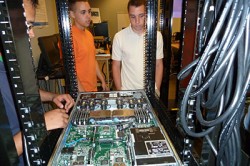
The teacher’s station for each classroom is equipped with a computer with dual monitors, one of which can be mirrored to the overhead projector. Also in the station is a document scanner, BlueRay player, and connections for a laptop. Some classroom management software is on each of the instructor machines but otherwise, the instructor computers are the same as the student computers.
To augment the networking equipment located at the front of the classrooms, 10 carts on wheels, each with routers, switches, a server, firewall, and a console, are available to be used in either classroom or elsewhere in the building. We have found that making sure that students have full view of the network (the raised flooring hides one run) from end to end aids in their understanding.
Last updated: 12/24/2023
